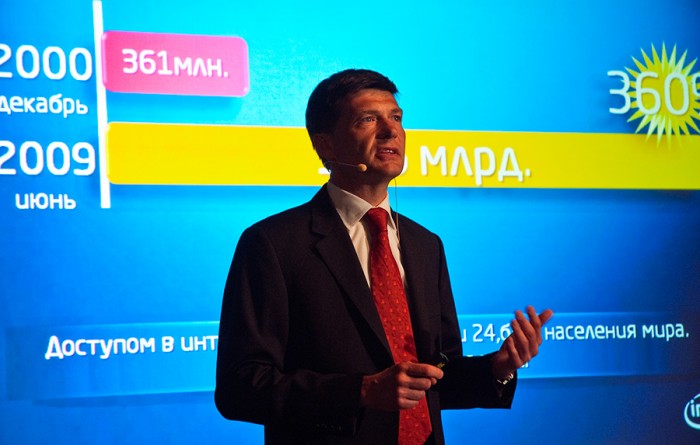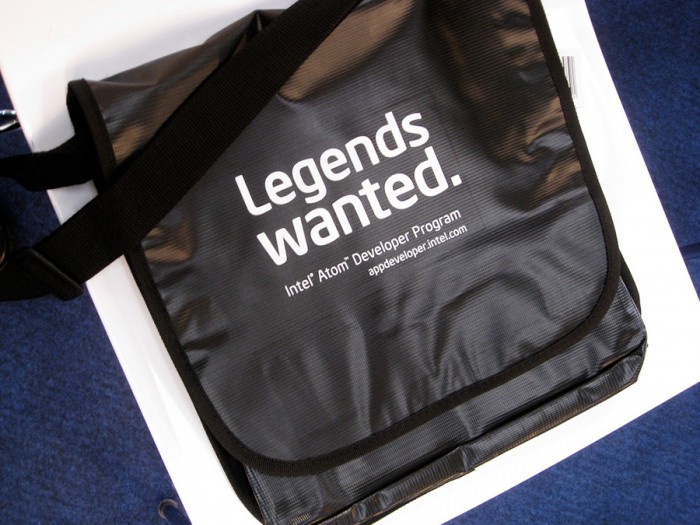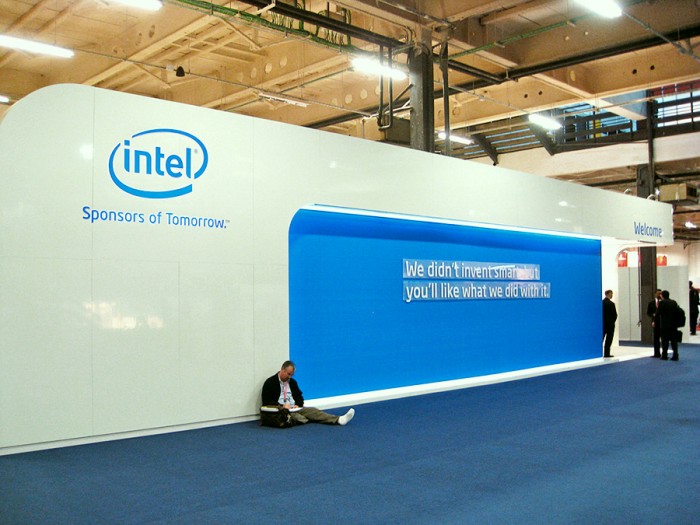About trends
The Mobile Congress - MWC 2010 ended the other day in Barcelona. A lot of technology and many new products were presented at the event that promise to enter our life in the near future - only the lazy did not write about all this.

In order not to be repeated again, in one long line: Microsoft showed the world a radically redesigned Windows Mobile 7; Finnish startup Aava Mobile, not particularly embarrassed by Nokia, introduced the concept of a phone based on Intel Moorestown platform (LG GW 990 was the first device on this platform) - MeeGo promises to be supported; Korean craftsmen from SK Telecom managed to introduce a processor and a gigabyte of flash memory with a recorded OS into a regular SIM card - now you can fantasize about various designers for mobile phones; by analogy, Sagem Orga put a Wi-Fi adapter into a similar SIM card - there were a lot of things, from which it became obvious that progress was not worth it!
It was no less interesting to observe the trends themselves - Dmitry Konash, Intel Regional Director for Russia and the CIS countries shared some observations and impressions: The

most important thing for us is the announcement we made with Nokia regarding the new MeeGo mobile platform. If earlier we focused on the Linux-based Moblin operating system, and Nokia worked on its version of its OS based on the same Linux, now we are joining forces and will work on this platform, which fuses the advantages of Moblin OS and Nokia interfaces. Of course, we are going to make MeeGo an open standard, because we hope for the support of a wide industry and we believe that the industry will benefit from this. Judging by the interest shown by the press in this announcement, we believe that this is the right step.

Intel has experience in developing processors and OSs for MIDs, Nokia has experience in developing a wide variety of mobile devices, but there is no experience in launching truly innovative products. Who will initiate innovation in this new alliance?
I think that this will be an equal partnership, because Nokia has some experience in the field of mobile OS, and in addition, the company is a world leader in the field of mobile phones and, of course, understands very well what the user needs in the field of interface, and in the field of functionality. Therefore, combining this experience with Intel's expertise in microprocessors, we hope that the platform will be positively accepted by the industry. Each of the two companies is a leader in its field, so this will be the interaction of two equal partners.
What are the main trends you noticed in Congress?
A large number of exhibition space is dedicated to mobile applications - apparently, this can be considered one of the main trends of this year’s mobile congress. If in former times a great emphasis was placed on hardware and equipment, then this year is a year of applications. Without mobile applications, it is now impossible to imagine the life of an ordinary person, businessman or employee of an enterprise, so the huge App Planet pavilion is dedicated to applications. Returning to MeeGo - I think the alliance with Nokia is a very timely decision, because we are pursuing an open door policy, we are not building a closed vertical ecosphere unlike some other companies, and we want to make MeeGo the most open platform for all market participants - such openness will allow a large number of companies to write applications for MeeGo.

The second big trend is the fourth generation Internet. We held a meeting for analysts along with a dozen mobile operators that work worldwide in the WiMAX standard, and I have to say that the hall was overloaded on Monday evening - interest in this area exceeded our expectations. At this meeting there were all the most significant analysts of the mobile and computer industry who could be imagined. The performances of operators who work with WiMAX around the world - in Asia, America, Europe - certainly aroused great interest. It is especially pleasant to note that the Russian company, Yota, which is the global leader in WiMAX today, was the leader in this show for analysts and the press. Representatives of Yota were not allowed to leave the stage, and after the event they were surrounded by a crowd of journalists and industry experts.
The market now has a fairly limited number of devices with built-in WiMAX - will WiMAX in the MeeGo platform, which is rapidly spreading across Russia, be taken into account?
There is no doubt about the future of the fourth generation Internet. Now there is a discussion about how this area will develop further - WiMAX or LTE. WiMAX is now about one and a half years ahead of LTE. Given that both technologies are quite similar to each other in terms of implementation, it can easily be assumed that after some time these two standards will merge, a single standard will appear that will be understandable to all market participants, and the only limiting factor today is that certain intellectual property payments that owners of this technology would like to collect from the market are associated with the LTE standard. The WiMAX standard is much more open, and payouts there are incomparably lower than in the case of LTE. It will be very interesting to observe how the dynamics of the relationship between the two standards will continue to develop in the next few years.
Why am I talking about this? Because, perhaps, it is the presence of two competing standards that to some extent inhibits the appearance of a variety of terminal devices that would support WiMAX or LTE.
If we talk about WiMAX, today in Russia alone there are more than forty kinds of different devices from about 7-10 manufacturers that support the WiMAX standard. This figure will only grow, because Intel’s new WiMAX modems are now qualifying, which, unlike the old ones, support not only 2.5 GHz, but also 3.5 GHz, and these are the two most established WiMAX frequencies used around the world, including including in Russia and the CIS countries, including Ukraine. All major laptop manufacturers today have models with WiMAX, and we believe that WiMAX will gradually flow into smartphones and other mobile equipment.

As another trend of this year, I expect the emergence of a number of tablet devices that support WiMAX technology. By the way, we demonstrated a number of prototypes of such devices - though behind closed doors, because we are talking about prototypes. But the devices are extremely interesting, they work on our new silicon with very low energy consumption, and I'm sure that by the end of the year at least some of these devices that we demonstrated as prototypes will appear on the Russian market. It is logical to assume that some of these devices will support WiMAX technology - simply because it is a trend of the times.
In Russia, three operators are now working with mobile WiMAX technology. These are Yota, Comstar and FreshTel, which last week launched in four cities near Moscow. We met with the management of FreshTel's Russian office at an exhibition in Barcelona, and they are extremely pleased with the start of sales. We are talking about the suburbs, where access to high-speed Internet is expensive, and, as FreshTel colleagues told us, people in some stores lined up almost from night, queuing up for modems - this is a completely different price range compared to what the fixed-line operators present in these four cities offer. So I believe that FreshTel made the right choice by going to the Moscow region, where competition is less and earnings are higher.
We are talking about three operators in Russia, about FreshTel, which is present in Ukraine, where it already really sells its services starting from the fourth quarter, and about Axoran in Kazakhstan, which is now testing the WiMAX network in Alma-Ata and is going somewhere in third quarter go commercial use. Five operators in three large CIS countries - the coverage is about 215 million people, and this is a very serious market in order to offer a large range of WiMAX devices.

The Congress in Barcelona made a very good impression on me. Its trend number one is the mobile Internet, and applications and flexible operating systems are trend number two.
Good luck!

In order not to be repeated again, in one long line: Microsoft showed the world a radically redesigned Windows Mobile 7; Finnish startup Aava Mobile, not particularly embarrassed by Nokia, introduced the concept of a phone based on Intel Moorestown platform (LG GW 990 was the first device on this platform) - MeeGo promises to be supported; Korean craftsmen from SK Telecom managed to introduce a processor and a gigabyte of flash memory with a recorded OS into a regular SIM card - now you can fantasize about various designers for mobile phones; by analogy, Sagem Orga put a Wi-Fi adapter into a similar SIM card - there were a lot of things, from which it became obvious that progress was not worth it!
It was no less interesting to observe the trends themselves - Dmitry Konash, Intel Regional Director for Russia and the CIS countries shared some observations and impressions: The

most important thing for us is the announcement we made with Nokia regarding the new MeeGo mobile platform. If earlier we focused on the Linux-based Moblin operating system, and Nokia worked on its version of its OS based on the same Linux, now we are joining forces and will work on this platform, which fuses the advantages of Moblin OS and Nokia interfaces. Of course, we are going to make MeeGo an open standard, because we hope for the support of a wide industry and we believe that the industry will benefit from this. Judging by the interest shown by the press in this announcement, we believe that this is the right step.

Intel has experience in developing processors and OSs for MIDs, Nokia has experience in developing a wide variety of mobile devices, but there is no experience in launching truly innovative products. Who will initiate innovation in this new alliance?
I think that this will be an equal partnership, because Nokia has some experience in the field of mobile OS, and in addition, the company is a world leader in the field of mobile phones and, of course, understands very well what the user needs in the field of interface, and in the field of functionality. Therefore, combining this experience with Intel's expertise in microprocessors, we hope that the platform will be positively accepted by the industry. Each of the two companies is a leader in its field, so this will be the interaction of two equal partners.
What are the main trends you noticed in Congress?
A large number of exhibition space is dedicated to mobile applications - apparently, this can be considered one of the main trends of this year’s mobile congress. If in former times a great emphasis was placed on hardware and equipment, then this year is a year of applications. Without mobile applications, it is now impossible to imagine the life of an ordinary person, businessman or employee of an enterprise, so the huge App Planet pavilion is dedicated to applications. Returning to MeeGo - I think the alliance with Nokia is a very timely decision, because we are pursuing an open door policy, we are not building a closed vertical ecosphere unlike some other companies, and we want to make MeeGo the most open platform for all market participants - such openness will allow a large number of companies to write applications for MeeGo.

The second big trend is the fourth generation Internet. We held a meeting for analysts along with a dozen mobile operators that work worldwide in the WiMAX standard, and I have to say that the hall was overloaded on Monday evening - interest in this area exceeded our expectations. At this meeting there were all the most significant analysts of the mobile and computer industry who could be imagined. The performances of operators who work with WiMAX around the world - in Asia, America, Europe - certainly aroused great interest. It is especially pleasant to note that the Russian company, Yota, which is the global leader in WiMAX today, was the leader in this show for analysts and the press. Representatives of Yota were not allowed to leave the stage, and after the event they were surrounded by a crowd of journalists and industry experts.
The market now has a fairly limited number of devices with built-in WiMAX - will WiMAX in the MeeGo platform, which is rapidly spreading across Russia, be taken into account?
There is no doubt about the future of the fourth generation Internet. Now there is a discussion about how this area will develop further - WiMAX or LTE. WiMAX is now about one and a half years ahead of LTE. Given that both technologies are quite similar to each other in terms of implementation, it can easily be assumed that after some time these two standards will merge, a single standard will appear that will be understandable to all market participants, and the only limiting factor today is that certain intellectual property payments that owners of this technology would like to collect from the market are associated with the LTE standard. The WiMAX standard is much more open, and payouts there are incomparably lower than in the case of LTE. It will be very interesting to observe how the dynamics of the relationship between the two standards will continue to develop in the next few years.
Why am I talking about this? Because, perhaps, it is the presence of two competing standards that to some extent inhibits the appearance of a variety of terminal devices that would support WiMAX or LTE.
If we talk about WiMAX, today in Russia alone there are more than forty kinds of different devices from about 7-10 manufacturers that support the WiMAX standard. This figure will only grow, because Intel’s new WiMAX modems are now qualifying, which, unlike the old ones, support not only 2.5 GHz, but also 3.5 GHz, and these are the two most established WiMAX frequencies used around the world, including including in Russia and the CIS countries, including Ukraine. All major laptop manufacturers today have models with WiMAX, and we believe that WiMAX will gradually flow into smartphones and other mobile equipment.

As another trend of this year, I expect the emergence of a number of tablet devices that support WiMAX technology. By the way, we demonstrated a number of prototypes of such devices - though behind closed doors, because we are talking about prototypes. But the devices are extremely interesting, they work on our new silicon with very low energy consumption, and I'm sure that by the end of the year at least some of these devices that we demonstrated as prototypes will appear on the Russian market. It is logical to assume that some of these devices will support WiMAX technology - simply because it is a trend of the times.
In Russia, three operators are now working with mobile WiMAX technology. These are Yota, Comstar and FreshTel, which last week launched in four cities near Moscow. We met with the management of FreshTel's Russian office at an exhibition in Barcelona, and they are extremely pleased with the start of sales. We are talking about the suburbs, where access to high-speed Internet is expensive, and, as FreshTel colleagues told us, people in some stores lined up almost from night, queuing up for modems - this is a completely different price range compared to what the fixed-line operators present in these four cities offer. So I believe that FreshTel made the right choice by going to the Moscow region, where competition is less and earnings are higher.
We are talking about three operators in Russia, about FreshTel, which is present in Ukraine, where it already really sells its services starting from the fourth quarter, and about Axoran in Kazakhstan, which is now testing the WiMAX network in Alma-Ata and is going somewhere in third quarter go commercial use. Five operators in three large CIS countries - the coverage is about 215 million people, and this is a very serious market in order to offer a large range of WiMAX devices.

The Congress in Barcelona made a very good impression on me. Its trend number one is the mobile Internet, and applications and flexible operating systems are trend number two.
Good luck!
